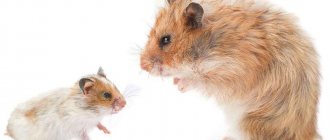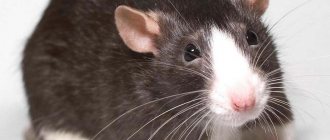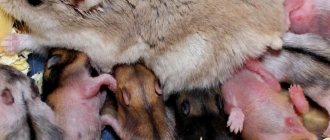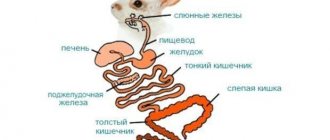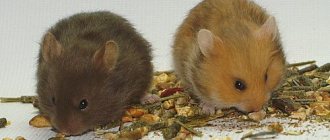How old do hamsters grow?
There is no clear answer to the question: “Until what age do hamsters grow?” It all depends on the breed. Hamsters are born small, about the size of a bean and weighing 3-4 grams. Cubs of small breeds (for example, Djungarian hamsters) grow for about 1-1.5 months. After this, the rodents become adults and begin to grow in width. Larger breeds (such as Syrian hamsters) take 1-2 weeks longer to grow.
IMPORTANT! It is not recommended to purchase hamsters older than 1 year, because... they are already elderly and not as active.
Age of puberty and reproduction
Puberty in hamsters occurs at the age of 1 month. In the period from 1 to 2 months, mating is not recommended, because the female is not yet mature enough: she needs time to prepare to create the next generation. It is necessary to wait until the skeleton and organs of rodents are fully formed, otherwise after premature mating they may give birth to underdeveloped offspring, and the female may eat them.
Males are able to fertilize a female after reaching three weeks of age.
The best time for the first mating is between 4 and 6 months of age. The next mating after the first can be carried out only after 2 - 3 months, because The animal needs time to restore its body after pregnancy and childbirth.
Females are able to give birth to offspring up to 1.5 years of age, and males retain reproductive function throughout their lives.
Repeated fertilization after the first in males is best done after 5 weeks, because the male may be weak for some time and not able to fertilize the female.
At the age of 20 days, hamsters can already eat protein foods
Rodent age in relation to humans
To make it clear to hamster owners what to expect from an animal of a given age, let’s compare it with human development.
Age tables according to human standards
| Hamster | Human |
| 0 days | 0 days |
| 15 days | 8-10 months |
| 6 months | 12 – 14 years old |
| 2 years | 50 - 60 years |
| 3 years | 70 - 80 years |
From the table we can conclude that the active period of life in hamsters begins at 15 days and lasts up to 24 months.
How to find out how many days or years old a hamster is
The skin of newborn hamsters is hairless and red in color. As they grow, it begins to change color and turns pink.
At the age of 6-8 weeks, baby hamsters begin to squeak and ask their mother for food. Their sparse fluff turns into thicker ones.
When they reach the age of 10-12 days, they are still blind, but crawl out of their house, exploring the world around them by touch.
At the age of 15-20 days, their eyes open and the fluff changes to thicker fur. They can already eat soft protein foods (boiled eggs, cottage cheese).
30-40 days after birth, they become adults, feed on their own and make their own nest. Some individuals defend their territories.
You can determine its age by the presence of hair in the ears of a dzhungarik.
Human and hamster years: how to compare
Now let's talk about how to compare the ages of a hamster and a human. If we take the life expectancy of a human to be 60-70 years, and a hamster’s to be 2-3 years, we will get the following ratio.
- A six-month-old hamster can be equated to a 12-year-old teenager.
- A one-year-old animal is a sexually mature adult.
- From the age of 1.5 years the animal enters the aging phase.
You can extend the life of your pet hamster if you take good care of it. Follow the recommendations of experts, and the animal will delight you for a long time and will become a real long-lived hamster.
Article on the topic: Who is better: a hamster or a rat, differences from a rabbit, chinchilla and parrot
Dzungariki
Behavioral differences
The behavior of individuals is the most distinctive feature in determining their age. Young individuals run actively, play a lot, chew food and make squeaks.
Older individuals are calm, move little, rarely eat and often sleep.
Hair in the ear area
In newborn Djungarians, the inside of the ears is covered with white soft hairs, which thin out and disappear over time. The complete absence of fuzz on the ears indicates old age of the individual.
Eyes
In young individuals, the eyes are the same color, slightly shiny and not very protruding. If cloudiness is observed in the eyes, most likely the rodent is old or sick and will not last long.
Wool
The thicker the animal's fur, the older it is. Young individuals have a brighter, richer coat color and no bald patches.
The coat of newborn hamsters is softer and smoother. Hamsters that are 5 days old are completely hairless and will not have hair for another 2 weeks.
14 days after birth, the color becomes variegated, and the coat becomes thick and smooth. By the middle of a hamster's life, the coat will be tough. The thicker the fur, the longer the rodent lives.
Weight
Weight and size also indicate the age of the rodent.
If the hamster is more than 8 centimeters in length, then most likely it is more than 2 months old. At the age of 5-12 months, dzhungariki weigh approximately 40 g.
IMPORTANT! When purchasing a hamster, it will be enough to weigh it to determine its age. Leading veterinarians recommend purchasing an animal at the age of 5–12 weeks of life. At this age, individuals get used to the world around them and are not particularly afraid; they are able to feed on their own.
It is worth noting that the weight gain of animals stops at 4 months.
Have you ever doubted the age of a hamster?
Dark spots
Another sign of determining the age of hamsters is the presence of age spots. They are located in the thigh area and resemble small seals. The color of the spots differs from the color of the skin. The more of them on the skin, the older the individual. Females have fewer pigment spots than males. The most noticeable ones are on the stomach and genital area.
Lifespan
The average lifespan of Djungarian hamsters is 2-3 years.
It is much more difficult for them to survive in the wild. This is due to dangerous factors found in nature: attacks by predators, poor tolerance to adverse weather conditions, eating at different times. Wild hamsters live 1.5 years.
Owners of domestic Djungarian hamsters surround them with care and attention, which is why the animals have a longer lifespan. With special and good care, you can extend their life to 3.5 years.
Young Syrians have black eyes
How long do cats and dogs live?
Let's start with how long our four-legged friends live. According to veterinarians, the lifespan of cats and dogs depends in part on the breed and size. Thus, the aging of cats and dogs differs not only from human aging, but also from each other. In general, larger animals have shorter lifespans. So, the life expectancy of a dachshund and a German shepherd are different things.
Veterinarians agree that a dog's breed and size are critical to longevity. At the same time, the nutrition and weight of animals are also important factors. But cats, as we know, do not differ much from each other in size, so the most important aspect of their healthy and long life will be mainly sterilization, nutrition and environment.
On average, the lifespan of a cat is 10-16 years, and dogs, depending on the breed and size, live from 10 to 13 years. By the way, you will find even more articles about scientific discoveries about pets on our Yandex.Zen channel.
Syrian or golden hamster
Behavioral differences
Young Syrian hamsters, like the Djungarians, are active, very active, curious about the world around them, love to play or run in a wheel, and like to stay awake at night. Sometimes they can be a little aggressive. At an older age, they become calmer and more sedentary.
Hair in the ear area
When examining a hamster, you need to pay attention to the condition of the fur near its ears and in the parotid area. In young hamsters, these parts are covered with an even, thin layer of white and fluffy hair. In older individuals, the ears are almost bare, and the remaining hairs on the ears grow noticeably.
Eyes
Young Syrian hamsters have black eyes, slightly bulging and slightly shiny. In healthy hamsters, the mucous membrane of the eyelids is pink and slightly moist.
If the eyes of Syrian hamsters are very shiny, have changed color, are covered with a yellowish film, are sunken, have popped out of their sockets, are dry or very moist, and the mucous membrane of the eyelids is inflamed - this indicates old age or illness of the hamster.
Wool
Syrian hamsters come in short-haired and long-haired varieties.
Long-haired dogs can also be “satin”. Their fur has a satiny sheen.
As they age, the color of Syrian hamsters darkens.
Golden rodents have gray small ears and black bangs. They have this coat color up to 8 months from birth. After 8 months of residence, their undercoats turn gray, but the upper hairs remain golden.
Smoky-pearl colored hamsters have gray fur and beige undercoats. As they get older, their coats may lighten. This is due to a varied diet at home.
Yellow-brown rodents have a rich honey-colored coat. The yellow tint takes up 30% of the total color. A distinctive feature is that these individuals retain their coat color throughout their lives.
Young animals have soft, thick and bright fur, but after two years it becomes hard and sparse.
Weight
The weight of a newborn Syrian hamster is 2-4 grams, and an adult – 100-125 grams. Moreover, their growth in length can reach 13 – 13.5 centimeters.
Dark spots
After one year of life, Syrian hamsters develop black spots on their bodies. They may be on the left and right lower back, as well as around the genitals, or the skin may darken in one patch. These are their glands that darken and become bulging with age.
Lifespan
Syrian hamsters live on average 3 years. If a rodent is provided with good care, it can live for 4 years. Because The average life expectancy of animals is 2 years; Syrian hamsters are classified as long-livers.
Young people are always active and playful
Breeding cycle
Pregnancy lasts about three weeks. You can bring a female and a male together only during the period of estrus, which occurs every 3-5 days, usually in the evening. At this time, Syrian hamsters secrete mucus from their genitals and a special musky odor appears, which attracts the male.
It is quite difficult to detect any physiological changes in dwarf breeds, be it Djungarian or Roborovsky. However, you can guess that the female is showing readiness to mate by her changed behavior.
She loses her appetite and stands motionless, with her paws spread wide and her back arched. During this period, the hamster reacts favorably to the approach and courtship of the male.
Pregnancy in animals lasts 16-21 days, in dwarf breeds - 22-24 days. After this time, from 5 to 12 cubs are born; they have no fur and weigh only 2-3 grams.
However, the hamsters already have teeth, after a week tiny fur appears on the body, and the most active babies can crawl out of the nest.
Other breeds
When purchasing a hamster of any breed, you can generally rely on the above points when determining their age. The exception is such a parameter as weight. It may differ for different breeds. And factors such as behavior, fur, ears and eyes are the same for all species.
IMPORTANT! It is worth paying attention to the following factors when choosing a hamster:
- if the hamster is more than 3 months old, it will weigh more than 40 grams;
- females increase in weight up to 4 months, after which she becomes an adult and her weight does not change, which indicates her readiness to mate;
- if the animal is more than 3 months old, its length will be at least 8 centimeters;
- young individuals are always playful and active, constantly eating, males start fights and attract females to their attention, and older animals behave calmly and stay away from everyone else.
Finding new owners for a hamster
Sooner or later it will be time to say goodbye to the grown-up fluffies. Not many people know when they can give babies to new owners. Usually animals are given away at the age of 1.5 months. In this case, the homa must:
- to cope calmly without a mother;
- be able to eat independently;
- use a drinking bowl;
- to be active.
New owners should be given recommendations on how to care for the animal, especially if this is their first hamster. You can also donate some of the bedding to put in a new cage. Since the baby will smell a familiar smell for the first time, he will quickly adapt to the new place of residence.
But where to find people who will take care of the kids, because not everyone is ready to take on such responsibility! First of all, ask your friends if they were just about to buy a hamster? You can also publish a post on social networks and on specialized portals with advertisements, attaching a photo of the furry.
What determines the lifespan of an animal?
Of course, the number of months lived will affect the pet’s life expectancy, but there are other factors that play an important role, for example:
- breed;
- heredity;
- conditions for keeping the animal before purchase;
- nutrition;
- care.
And if you can’t argue with nature, and we are unable to influence the breed and heredity, then the worthy maintenance of a pet depends only on us.
Even if before the purchase the rodent was not treated in a completely appropriate manner, after the purchase everything depends directly on the owners. Provide your baby with decent living conditions and, perhaps, the animal will live with you for three or even four years.
Preparing for a new addition to the family
After you have established the fact of pregnancy, you need to prepare for replenishment. The most important thing an expectant mother needs is peace. A couple of days before the expected event, you can no longer approach the cage without reason, move the bedding and try to play with the hamster. Therefore, preparation must be done in advance.
This is what the expectant mother needs:
- Lack of a partner. A week before giving birth, the male should be transplanted into another cage. It should not distract the hamster from preparing for childbirth and nursing the offspring.
- Revision of nutrition. The percentage of protein in the female's diet should be increased. Buy her a special protein food, little by little give her boiled egg whites and low-fat cottage cheese in small quantities to replenish calcium losses.
- Purity. It is necessary to clean the cage in advance. 2-3 days before the addition to the family, the hamster will not allow you to do this. Therefore, clean up after you remove your partner from the cage. It is worth keeping in mind that after giving birth, the bedding cannot be changed for 2 weeks (so as not to harm the babies and not irritate the young mother). Based on this, sawdust should be poured 2-3 times more than usual.
- Space. Remove the wheel and other attractions from the cage, because the hamster will have no time for sports in the near future; the toys will only get in the way. But leave the house, where a caring mother can hide supplies.
- A lot of food. In the first week after birth, you should not climb into the cage. Therefore, replace the food bowl with a larger one and fill it to the top with dry food for rodents.
- Nest material. Of course, you can make a nest from sawdust, but it will seem hard and prickly to the kids. Throw paper napkins or toilet paper to the hamster, she will use it for construction.
Attention! Do not put large quantities of fruits and vegetables in the cage! They spoil very quickly. It’s better to stick a small piece through the bars once a day.
While the female is preparing for childbirth and feeding the hamsters, your task is to find a new family for the babies.
